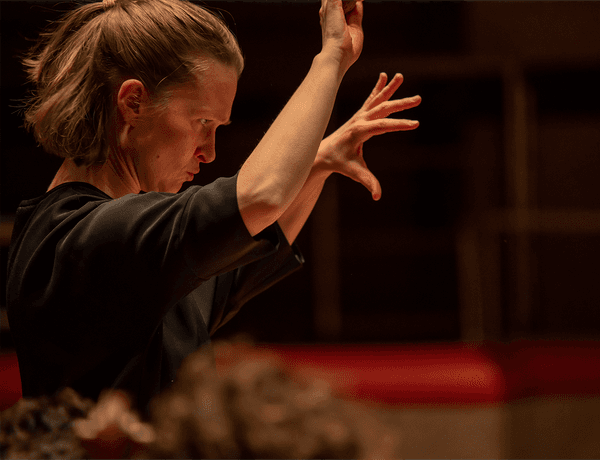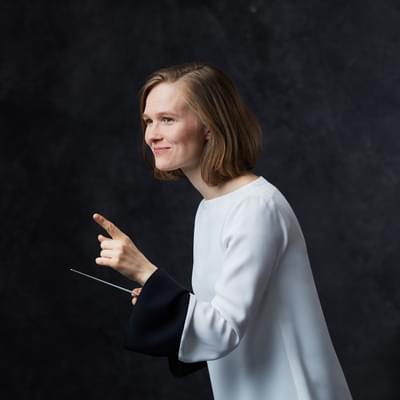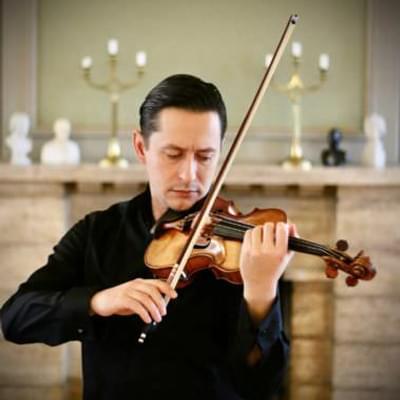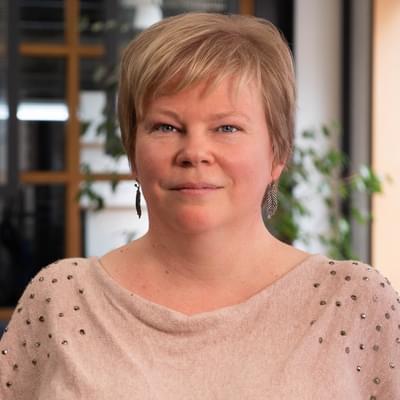From Mirga With Love

Full programme
- Anksti Rytą Kėliau (arr. Raminta Šerkšnytė), Lithuanian Folk Song (4mins)
- Čiurlionis, In the Forest (18mins)
- Weinberg, Clarinet Concerto (25mins)
- Loboda, Requiem for Ukraine (4mins)
- Weinberg, 12 Miniatures for Flute (20mins)
- Kakhidze, Brotherhood (32mins)
Performers
Introduction
My dad and my brother have said numerous times since Russia invaded Ukraine that they would go to the front and fight. We Lithuanians experienced so much crime from Russia that it feels as if the war is happening to us. “I feel it physically, in my own body, every day”, - again my Dad.
Poland was the first country to make the decision to not showcase any Russian art until the former red army leaves Ukraine in peace. Lithuania soon followed suit. I feel torn knowing this since I LOVE Russian music, literature and art - I am quarter Russian after all! Now though, we must focus our view on the “post-soviet” countries. We must explore the great work their people have created and therefore acknowledge the existence, identity and independence of those free countries.
That is why this programme is purely Georgian-Lithuanian-Polish-Jewish-Ukrainian. So many unknown pieces, and quite a few British premieres!
I imagine that by now, many of you will know the name Mieczysław Weinberg. His two concertos we are performing tonight show the wide arc from the early to the late work by Weinberg. He composed the Twelve Pieces for Flute in 1945, and the Concerto for Clarinet in 1970. Between which he suffered under Jewish discrimination, humiliation by the Soviet government, the loss of his stepfather who was murdered by the latter, and imprisonment. The early work for flute is very much influenced by Baroque and Bach as well as by Impressionism. The late clarinet concerto reveals the composer’s close relationship to Shostakovich. We hear the depth of Weinberg’s big opera “The Passenger” in this piece.
Folk songs are crucially important for the (smaller) countries that have big and aggressive neighbours. If those neighbours undertake violence, singing helps to remember their right to exist and to dream of a better future. “Requiem for Ukraine” by Igor Loboda, based on a Ukrainian folk song, is the heart of this programme.
Unwind with a beautifully simple melody and a jazzy rhythm - Vakhtang Kakhidze's "Bruderschaft" provides the perfect ending to the concert.
The beginning is “Miške” - “In the Forest” by Mikalojus Konstantinas Čiurlionis. All the Lithuanian musicians take influence from him. His paintings, literature and music - an endless spring of inspiration. “I imagine the world as a big symphony” - Čiurlionis.
I am sad I will not see all of the CBSO musicians this time: the size of the orchestra turned out to be quite small in all the pieces except Čiurlionis. It feels very right for this specific programme though, since we will have an unusually big number of CBSO soloists completely in spotlight: thanks Marie-Christine, Oli, Eugene and Adam for being open to the pieces in tonight’s programme!
Mirga Gražinytė-Tyla, Conductor and CBSO Associate Artist
Programme Notes
Tonight, Mirga Gražinytė-Tyla takes us on a very personal tour of Eastern Europe, from Georgia to the Baltic. There will be gripping new discoveries from her personal favourite Mieczyslaw Weinberg and Čiurlionis, the “Lithuanian Elgar”, takes us on a walk through the forests. We'll also see a whole host of CBSO musicians step into the spotlight, before Mirga's sister joins the orchestra on stage. The results will be simply gorgeous…
In the Forest
Mikalojus Čiurlionis (1875-1911)
Mikolajus Čiurlionis studied in Warsaw and Leipzig but came to be associated with the nascent Lithuanian school of art after 1905, when sweeping reforms across what was the then Tsarist Empire allowed for expression of explicitly Lithuanian identity. At that time, Čiurlionis had been on tour in the Caucasus but returned to Vilnius with a triumphant art exhibition in 1907. Čiurlionis was arguably the leading artistic personality of the nation, just as successful with his paintings as with his music, and he proved adept at rallying and organiser followers to take up the Lithuanian cause in their own art. His symphonic poem In The Forest was written in 1900 and betrays the influence of Sibelius and Grieg, but there is a distinctly Lithuanian character to be heard across the work also. It opens with a quiet and still beginning, reminiscent of pine forests, but quickly expands in energy and is every bit as demanding and exciting as Strauss’s earlier tone poems. Intriguingly, Čiurlionis experienced synaesthesia (a blending of the senses) and he painted a number of images around 1907-1908 also titled ‘The Forest’; together they can be understood as a ‘total artwork’, encompassing sound and image. According to letters from the time, Čiurlionis had completed the piano score of the work within just 12 days, but then spent months expanding it for orchestra. His Lithuanian heritage proved a barrier for the work, though: it won first prize in a Polish competition, but its original premiere was cancelled explicitly because Čiurlionis was not Polish. In the Forest was only performed after Čiurlionis’s death at the tragic age of 35.
Clarinet Concerto
Mieczysław Weinberg (1919-1996)
Weinberg wrote his concerto for Clarinet in June of 1970. It is a more personal and expressive work than either his Cello or Trumpet Concertos that he had previously finished, and the Clarinet writing here is more demanding than that seen in his Clarinet Sonata, his only major work for the instrument before this one. There is also none of the Klezmer-style melodies so often heard in Weinberg’s chamber music, and clarinet writing especially. The concerto opens with a sparsely-textured Allegro movement, with the soloist giving a rocking and spiky melody against pizzicato accompaniment which generates energy; the contrasting theme sees the clarinet climb into its high register. In the central section, the parts reverse roles, before the initial themes are repeated in unusual juxtapositions. The middle Andante movement is a slow lyrical rumination on the ideas from the first movement, but the energy continues to remain and spills over into the finale. Here, there is a kind of melancholy dance with more than a fair dose of humour alongside, contrasted with a military march that seems to then brutalise the original idea. The dancing idea continues, along with markers for a false ending and a virtuosic cadenza. Weinberg’s Clarinet Concerto seems to have been unperformed during his lifetime, though it is being performed more frequently in the ongoing revival of Weinberg’s music, of which the CBSO continue to be major proponents.
Requiem for Ukraine
Igor Loboda (b. 1956)
Igor Loboda is a Georgian composer and violinist who combines Russian, Georgian, and Ukrainian elements in his music to produce tuneful and emotive works that encompass multiple traditions. Following the Russian annexation of Crimea in 2014, Edition Salzberger, together with violinist Lisa Batiashvili, commissioned this short requiem piece for solo violin from Loboda to mark the Ukrainian day of Independence (24th August). The moving melody is itself expanded from a Ukrainian folk melody that sings of the river Dnieper. After a solemn presentation of the melody, there is a more complicated and hurried sequence of variations upon it that demands virtuosic playing and suggests a sense of indignation. While The piece then returns to the more contemplative tone with which it opened, to conclude with a similarly solemn presentation of the melody but now with a tone of defiance, seemingly changed by the events preceding it.
The Requiem for Ukraine has been a moving tribute since its premiere, but it has taken on special significance since the full Ukraine war and Russian invasion in February 2022. The piece is dedicated to all the victims of the Ukraine conflict since 2014.
Twelve Miniatures for Flute
Mieczysław Weinberg (1919-1996)
Weinberg’s Twelve Miniatures for Flute and Piano was written straight after finishing his Clarinet Sonata and finished in just a single week in Nov-Dec 1945. While the title would suggest a disparate string of pieces, there is a clear sense of a cyclic design over the work. The first miniature is almost entirely for the flute, with two for the accompaniment alone (nos. 2 and 7), and the final three are linked attacca (without interruption) together. There is also a strict organisation of keys and modes across the 12 pieces, starting in D flat major for the opening, then D minor, then E-flat major, and so on. The demands on the Flute soloist vary from piece to piece, but it is the expressive arc of the overall set that unites this as an impressive piece and demonstration of Weinberg’s mastery of woodwind instruments. As with the Clarinet Concerto, there is no record of a premiere performance for this piece, but Weinberg did return to it in 1983 to arrange it for Flute and String Orchestra at the request of Aleksandr Korneyev, one of the leading Soviet flautists. The Twelve Miniatures were presumably close to Weinberg’s heart, as he reused several of the melodies in later works, including his operas. As a set, they provide an interesting counterweight to his later Flute Concertos, and they have risen in popularity among contemporary flautists in both the piano and chamber orchestra versions.
Brotherhood
Vakhtang Kakhidze (b. 1959)
Vakhtang Kakhidze is a Georgian composer and conductor, noted for his passionate communicative works that blend elements of classical with jazz. Kakhidze is part of a tradition of composition that, via Edison Denisov, has links to Shostakovich, but his musical language is very much his own, with strong representation of Georgian roots and ideas. Kakhidze is an extraordinarily prolific composer, with works including popular music, jazz, film music, and concert works, and he is the chief conductor of the Tbilisi Symphony Orchestra. His 1996 Brotherhood is scored for solo viola, piano, and string orchestra, and the piece presents a mix of motifs from jazz, classical, and folk roots. It opens with protracted exchanges between the viola soloist with the orchestra calmly accompanying with slow chords that unfurl and spiral in an extraordinary meditation. Energy soon accrues and by the central section the piece has become an energetic dance, with an infectious blend of jazz and folk motifs. The energy increases but eventually gives way to the same stillness and tenderness with which the piece began – but with a new twist, a whispery down-bow from the whole string orchestra to conclude.
© Daniel Elphick is a lecturer in Musicology at Royal Holloway, University of London, specialising in Russian and East-European Music since 1800. His book Music Behind the Iron Curtain is available from Cambridge University Press.
Featured image © Beki Smith





